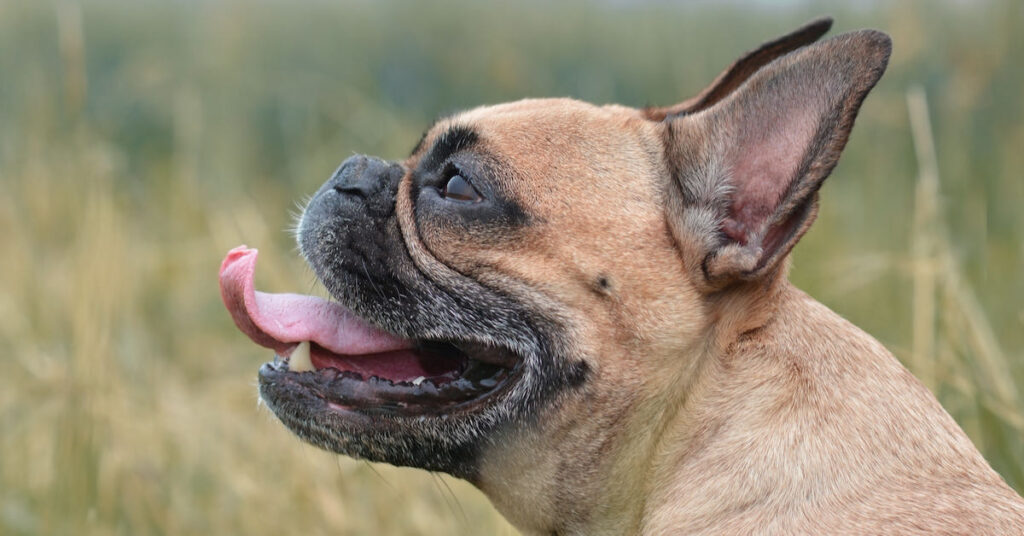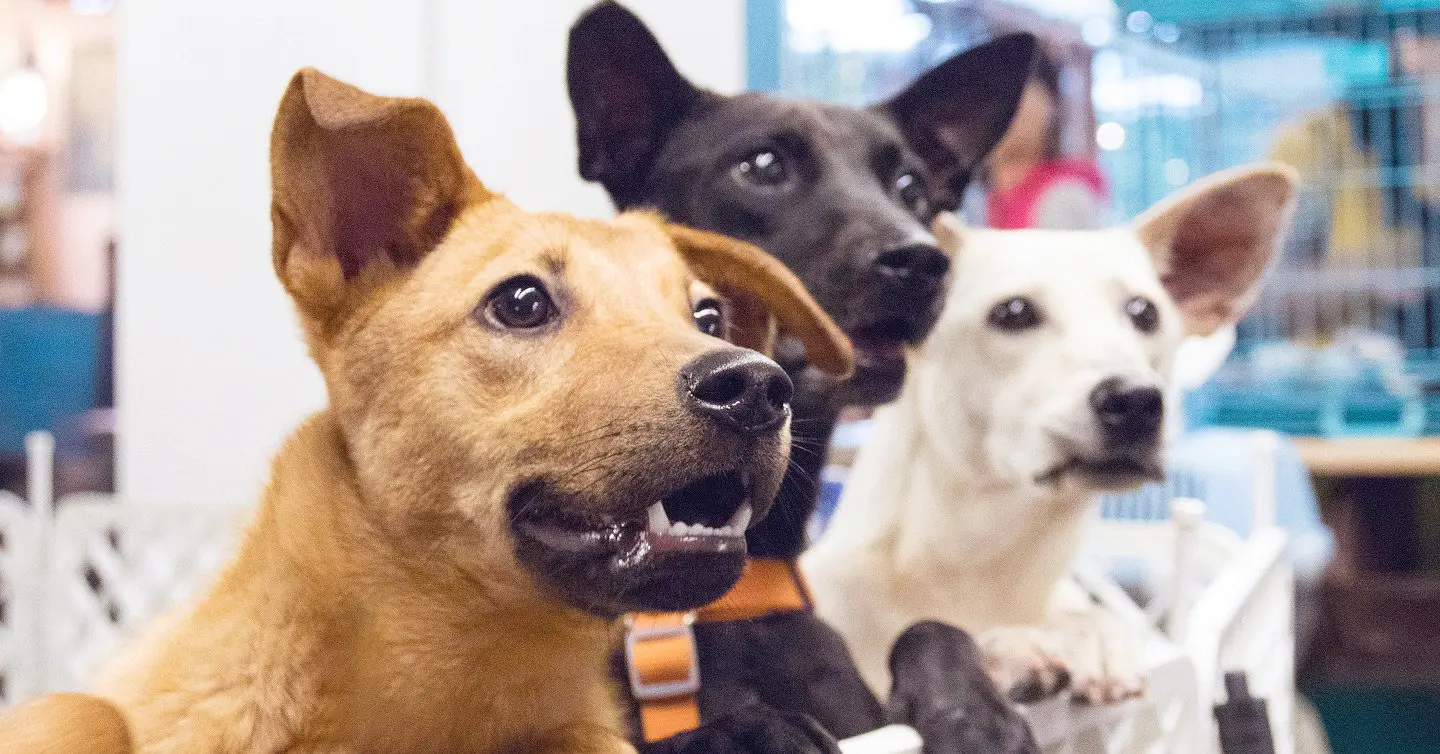Key Points
- Some of the most popular brachycephalic dogs include the French Bulldog, Affenpinscher, Shih Tzu, Pug, Pekingese, and Boston Terrier.
- Smooshed face cuteness also comes with higher health costs from dental concerns, skin fold dermatitis, eye injuries, and breathing problems.
- With diligent care, you can help prevent dental and skin issues at home, while some breathing concerns may require surgery to repair.
Have you ever seen a dog with a smooshy face that was so adorable you wanted to cry? This is a brachycephalic dog, also called a flat-faced dog breed or a short-nosed dog.
The word “brachycephalic” comes from two Greek words that mean “short” and “head.” Brachycephalic dogs typically have a broad head, large eyes, and rolls of skin or wrinkles on their face. While this distinctive look is endearing to their owners, their compact skulls increase the risk of health concerns that affect your pup’s well-being.
If you’re considering adopting a brachycephalic dog, take the time to learn about these breeds’ common health problems. In this article, we’ll share info on these concerns, and introduce you to some of our favorite smooshed-face dog breeds.
Popular brachycephalic dog breeds

All of these smooshed face dogs, with their wrinkles and expressive eyes, hold a special place in our hearts:
French Bulldog: These dogs are best known for their distinctive bat-like ears, friendly temperament, and expressive, alert eyes. They are a popular companion and one of the most popular dog breeds in the world.
Affenpinscher: Also known as the “Monkey Terrier,” this small dog has a shaggy, wiry coat and monkey-like face. They are alert, adventurous, loyal, and affectionate with their family.
Shih Tzu: This toy breed is renowned for its long flowing coat and sweet, expressive face. Their friendly and outgoing personality has made them a favored companion for centuries.
Pug: This compact and muscular breed has a distinctive wrinkled face and large, soulful eyes. They are known for their charming and mischievous personality, which make Pugs beloved and goofy pets.
Pekingese: This ancient toy breed is distinguished by a lion-like mane and flat face. They have a regal demeanor with a long flowing coat and confident character.
Boxer: Boxers are medium-sized, muscular dogs known for their boundless energy and strong build. They have a distinctive short, square muzzle and are playful pets and vigilant guardians.
Boston Terrier: You can easily recognize this small and compact terrier thanks to their tuxedo-like black and white coat, square head, and large eyes. The breed is affectionate, friendly, and intelligent.
English Bulldog: This breed has a sturdy stance, a gentle disposition, and a calm and courageous demeanor. Their bodies are broad and compact, with distinctive pushed-in noses, and wrinkled faces.
Shar Pei: A distinctive Chinese breed known for its loose skin and deep wrinkles, especially around the neck and face. They have a sturdy strong build and are a devoted companion and protector.
Cavalier King Charles Spaniel: This small, affectionate breed has expressive eyes and a silky coat. They are friendly and adaptable, easily suited for an active lifestyle or as a lapdog companion.
What is brachycephalic syndrome in dogs?
Brachycephalic dogs are the result of generations of breeding, which specifically favored dogs with certain aesthetic features.
Brachycephalic Airway Obstructive Syndrome (BAOS) is an anatomical abnormality that affects flat-faced dog breeds. Key characteristics include a shortened skull and narrowed nostrils that compress the upper airway.
Brachycephalic dog breeds also have a longer soft palate, which increases the risk of laryngeal collapse. The laryngeal area is the part of the throat where the voice box sits. It’s at the top of the trachea and plays a crucial role in breathing and swallowing. If there is laryngeal collapse, it can close off the airway.
BAOS may also trigger everted laryngeal saccules. These are small structures within the larynx between the vocal cords and the entrance to the larynx. Under normal conditions, they serve to maintain an open airway. The increased effort of breathing may cause these to pull outward into the laryngeal opening, contributing to airway obstruction.
Brachycephalic syndrome in dogs triggers breathing difficulties that result in symptoms like exercise intolerance and heat insensitivity. Dogs release heat from their body by panting. With a shortened head and trouble exchanging oxygen, they can also be more sensitive to warm weather and heavy activity.

Brachycephalic airway syndrome can also trigger gastrointestinal issues from swallowing air while they eat. This could include frequent vomiting, gagging, and belching. The anatomical challenges of dogs with a smushed face can also cause problems with breathing during sleep, including obstructive sleep apnea.
In most cases, BAOS is diagnosed when your puppy is between the ages of 1-4 years old, and males and females are affected equally. Your vet diagnoses BAOS based on your dog’s breed, symptoms, and physical examination. They may recommend light anesthesia to examine the back of the throat, looking for a long soft palate and laryngeal saccules. Your vet may use X-rays to evaluate the size of your pup’s trachea, the tube that leads into the lungs.
Health issues in brachycephalic dogs
Brachycephalic dogs can experience several types of common health conditions. Understanding these health problems can help you make an informed decision about whether you are financially and emotionally ready to adopt a pet that may require more grooming and veterinary care than the average dog.
Dental problems
Flat-faced dogs typically have a smaller mouth, misaligned jaw, and overcrowded teeth. This can lead to another common brachycephalic dog problem: dental disease and periodontitis. Periodontitis is a form of gum disease that increases pain and tooth loss from a buildup of bacteria and plaque on the skin.
Dental disease can make your dog’s breath smell bad and periodontitis can lead to significant mouth pain and tooth loss, affecting your pup’s ability to eat comfortably.
Skin Fold Dermatitis
While the wrinkles on their face are adorable, they can trap moisture and debris that lead to irritation and infection, called skinfold dermatitis or intertrigo.

Eye Injuries
Most brachycephalic dogs have large eyes and shallow sockets, which increase the risk of problems, including injuries, ulcers, and prolapse. When an eye prolapses, the eyeball comes out of the socket and protrudes from the eye cavity, also known as cherry eyes.
C-sections and birth Injuries
Most female brachycephalic dogs have trouble giving birth, which often necessitates a Caesarean section. This is because the puppies have larger heads relative to their mother’s pelvis, which can lead to the death of the mother and puppies during a natural birth.
Treatment for brachycephalic dogs
Brachycephalic dogs require specialized care to support their health and quality of life. Let’s discover what health concerns may need to be addressed before welcoming one of these breeds into your home.
Lifestyle changes
Several small lifestyle changes can help treat mild cases of brachycephalic airway syndrome and improve your pup’s quality of life:
- Use a harness instead of a neck collar to reduce pressure on the trachea and neck area.
- Ensure your pup maintains a healthy weight to avoid stress on the respiratory system.
- Avoid excess heat and humidity and control their physical activity to help reduce the stress of breathing.
Surgery
Severe cases may require surgical correction to help your dog breathe easier. The earlier the surgery, typically the better the outcome. A surgical procedure may help correct narrow nostrils, remove everted saccules, and shorten a long soft palate. Unfortunately, some brachycephalic dogs also have a narrow trachea, and, at this time, there is no treatment or surgical procedure to correct this.
In an emergency, a tracheostomy may be necessary to ensure your dog can breathe. This is a tube that’s inserted into the trachea from a hole created in the neck. Surgery also carries some heightened risks for brachycephalic dog breeds. This can include anesthesia, bleeding, and swelling.
Skincare
Your dog’s skin folds and wrinkles will trap moisture and debris, which can lead to irritation and infections. Treatment will address the bacterial infection and inflammation of the skin.
The best way to address this is through prevention. You will need to thoroughly clean and groom your dog frequently, keep the wrinkles dry, and avoid overexertion.
Birthing care
Many female brachycephalic dogs will require a cesarean section to give birth. Among English bulldogs, the rate of cesarean births is as high as 86%. If you have a pregnant female dog, discuss emergency procedures with your veterinarian before it’s time for the puppies to be born. If you notice any difficulty during birth, your dog will need emergency care to prevent the death of the mother and puppies.
Make an informed choice
You should always understand common problems with brachycephalic dogs before welcoming them into your home. You’ll need to take certain steps to ensure they live a happy and healthy life. For example, keeping them slim is vital to their health and respiratory tract. However, you must also avoid excess exercise that can cause breathing problems or overheating.
Caring for any new dog can be expensive, especially if they have challenging health needs. Learn more about how Pumpkin Pet Insurance plans can help you afford the best care for your pup by covering eligible vet bills for future accidents and illnesses.
FAQs
-
- https://www.merckvetmanual.com/multimedia/table/what-is-a-brachycephalic-dog-breed
- https://vcahospitals.com/know-your-pet/brachycephalic-airway-syndrome-in-dogs
- https://www.humanesociety.org/resources/flat-face-dog-breeds-and-health-issues
- https://healthtopics.vetmed.ucdavis.edu/health-topics/brachycephalic-short-nosed-dogs
- https://kb.rspca.org.au/knowledge-base/what-do-i-need-to-know-about-brachycephalic-dogs/
- https://todaysveterinarypractice.com/dermatology/skin-fold-dermatitis-intertrigo-in-dogs/
- https://www.vet.cornell.edu/departments-centers-and-institutes/riney-canine-health-center/canine-health-information/brachycephalic-obstructive-airway-syndrome-boas
- https://www.thekennelclub.org.uk/health-and-dog-care/health/health-and-care/a-z-of-health-and-care-issues/birthing-difficulties-brachycephalic-dogs/




